|
Early work |
Influences and experimentation |
A return to naturalism
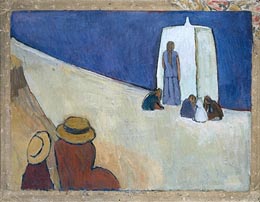
Vanessa Bell, Studland Beach, circa 1912
© 1961 Estate of Vanessa Bell |
In Studland Beach, a major work from 1912, the people and landscape have been dramatically simplified, the crouching figures, beach houses and seascape
becoming flattened shapes and broad bands of colour.
In these paintings we see Bell emphasising form over content, the main theory of Modernism.
Although written for a 1930 exhibition catalogue, Virginia Woolf's observations about her sister's painting could as well be applied to Studland Beach.
| No stories are told; No insinuations are made.
The hillside is bare; the group of women is silent; the little boy stands in the sea saying nothing. |

Virginia Woolf, Recent Paintings by Vanessa Bell, Cooling Galleries, 1930 |
|
In the same year Bell painted two artist friends, Frederick and Jessie Etchells, painting.
Their faces are left blank without detail and again, broad bands of loosely-painted colour are used to suggest background.
Four of Bell's paintings were included in Fry's Second Post-Impressionist Exhibition in London in 1912, where they hung alongside works by Matisse, Picasso and Derain.
Julian Bell with Frederick and Jessie Etchells

© Tate Archive, 2003 |
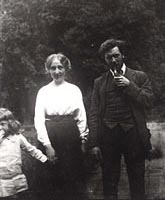 |
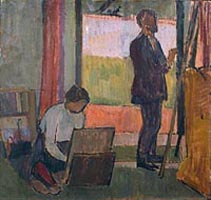
Vanessa Bell,
Frederick and Jessie Etchells painting, 1912
© 1961 Estate of Vanessa Bell |
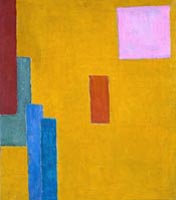
Vanessa Bell,
Abstract Painting, circa 1914
© 1961 Estate of Vanessa Bell |
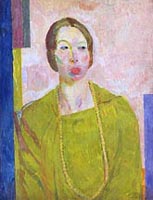
Vanessa Bell,
Mrs St John Hutchinson, 1915
© 1961 Estate of Vanessa Bell |
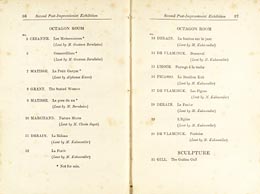 |
In her pursuit of Modernism, Bell was inevitably led to experiment with complete abstraction. In Abstract Painting she used blocks of colour to build up her design,
and in doing so became one of the first artists in England to paint in an abstract style, confirming her position as a member of the avant-garde.
She also used this technique as a background in figurative works.
For example in her portrait of her husband's mistress, Mrs St John Hutchinson, 1915, background strips of colour are used to give a structure to the work.
 Page from Second Post-Impressionist Exhibition
catalogue, Grafton Galleries, 1912
Page from Second Post-Impressionist Exhibition
catalogue, Grafton Galleries, 1912
© Annabel Cole
|
The influence of abstraction is still apparent in paintings such as The Tub of 1917 with its simplified background, although from around this time she returned to a
more figurative style.
A letter to Roger Fry of 1918, in which she discusses the painting, provides us with an insight into her approach:
| I've been working at my big bather picture and am rather excited about that.
I've taken out the woman's chemise and in consequence she is quite nude and much more decent. |

Letter from Vanessa Bell to Roger Fry,
1 January 1918 |
In this photograph of an earlier version of the painting, the bather is still wearing the chemise. |
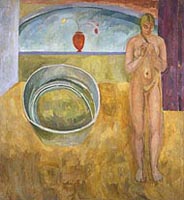
Vanessa Bell, The Tub, 1917
© Tate Archive, 2003 |
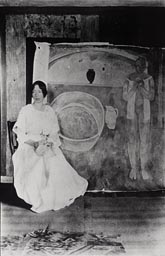
Mary Hutchinson with
Vanessa Bell's painting, The Tub
© Tate Archive, 2003 |
|
